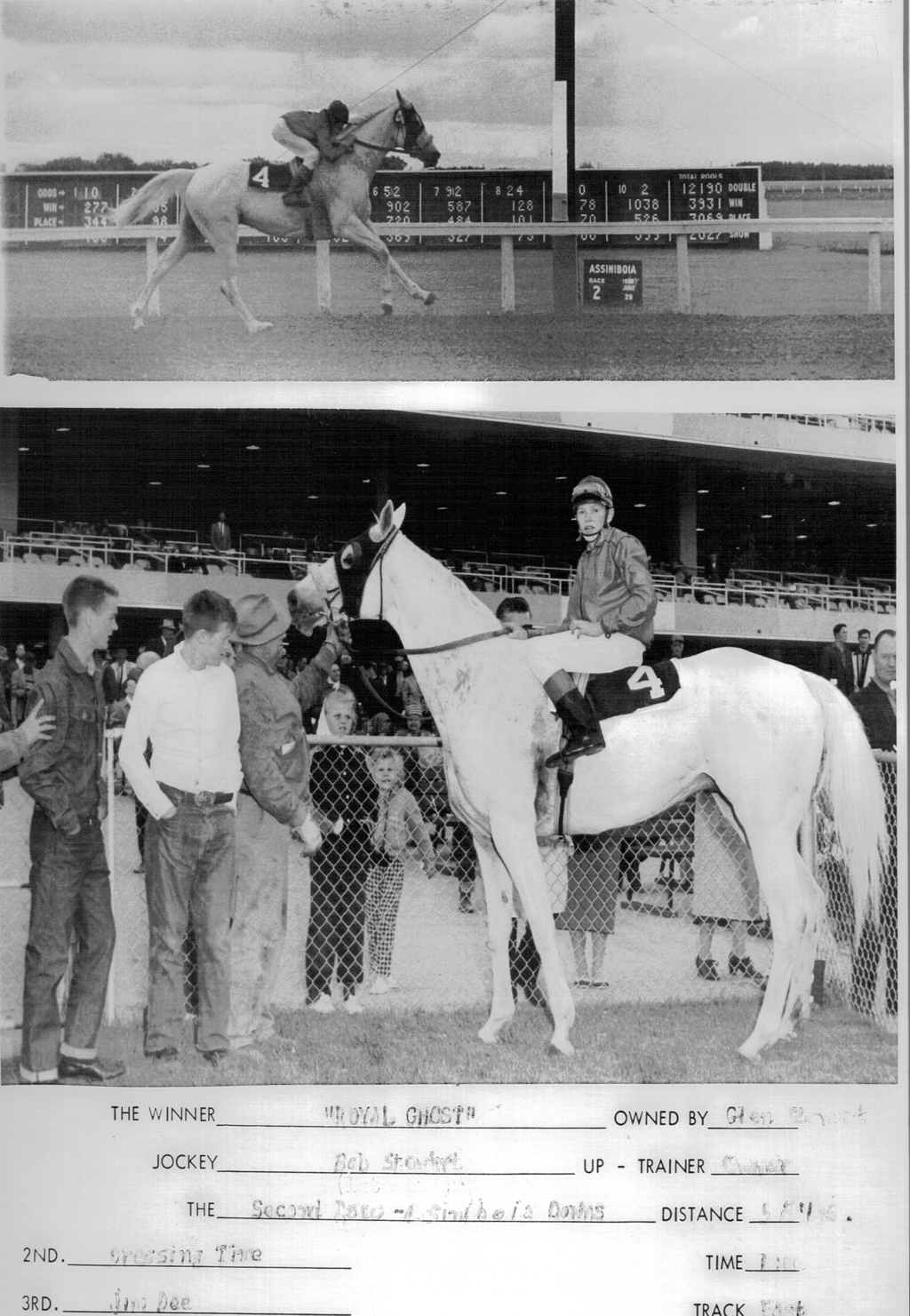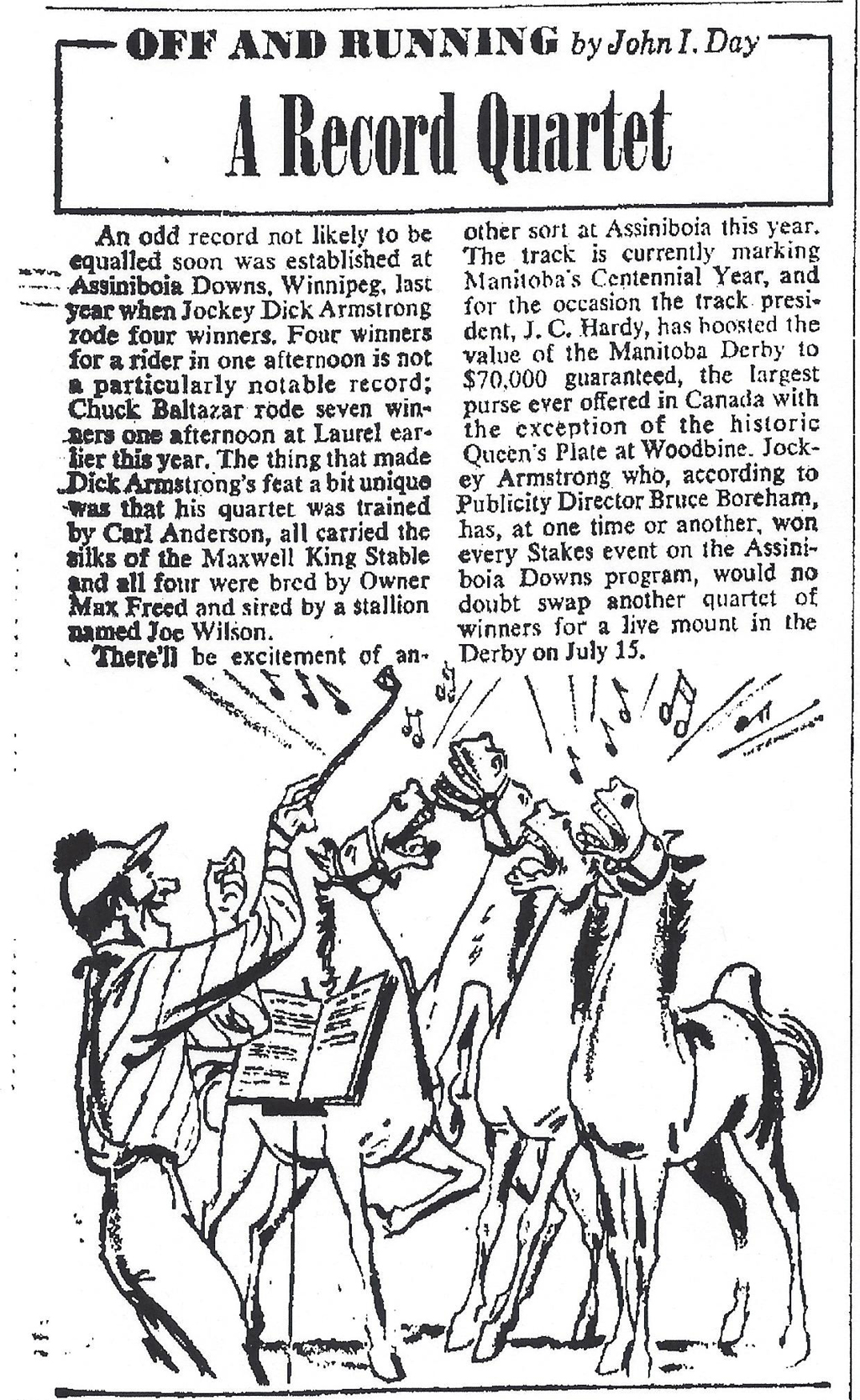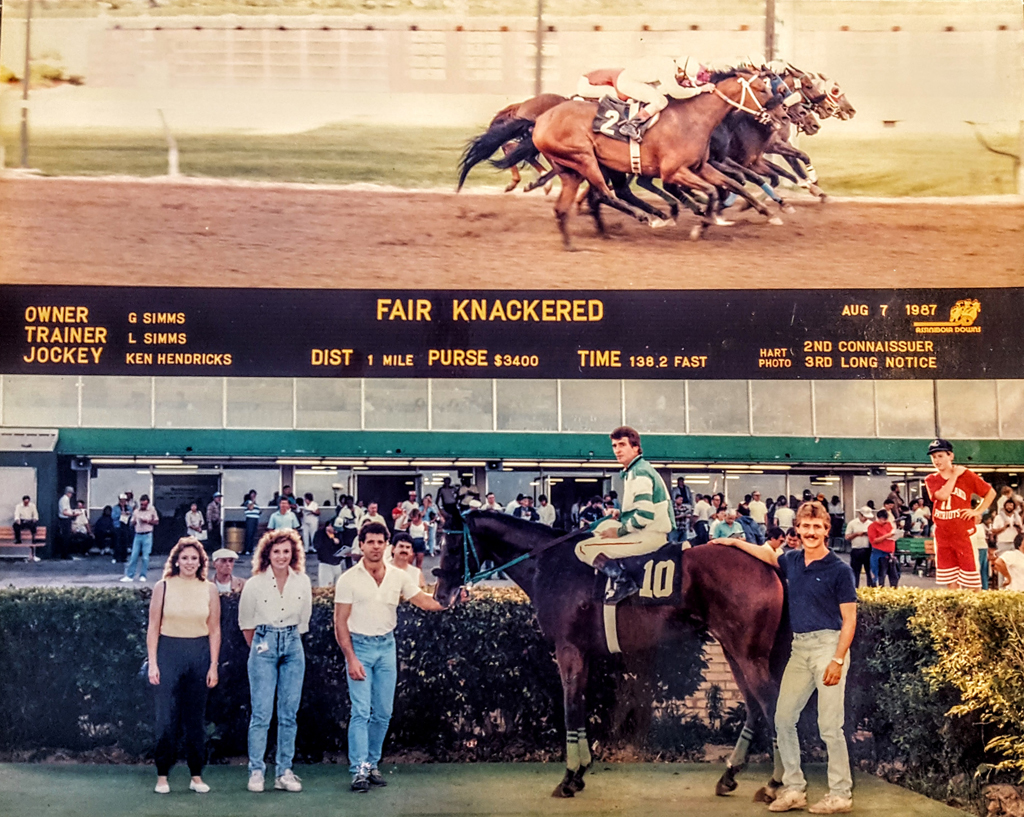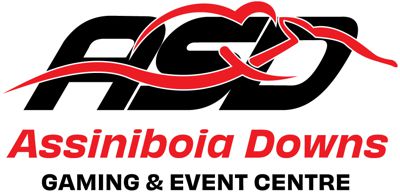
by Bob Gates
Not even Looney Tunes with its wascally wabbit has anything on thoroughbred horse racing when it comes to the zany and unusual. From the annals of Winnipeg turf lore, few stories rival the wondrous happenings at Assiniboia Downs or at Jimmy Speers’ old haunt, Polo Park racetrack.
Polo Park was the scene of an unusual “show” payoff on September 4, 1950. The 7th race winner Black Deer paid $8.30, $5.45 and $5.00 across the board, but the runner-up, Sunny Time set off alarms when it paid $15.20 to place and $88.05 to show. The difference between the place and show price was extreme to say the least. The 7th race was a Quinella with fewer punters bothering to bet win, place, show. Only three $2.00 show tickets were sold on Sunny Time, who, had he won, would only would have paid $29.60.
On June 29, 1960 Bobby Stewart rode his first ever winner on a recognized racetrack. The horse was 10-year-old Royal Ghost, who was owned by Bobby’s father, Glen. It was young Stewart’s first year at the Downs, and he scored six wins in 1960, three of which came courtesy of Royal Ghost. The odd part here was that the win prices for Ghost were scary. He paid double digits each time: $22.50, $33.80 and $37.50.

Royal Ghost paid some scary big prices. Bobby Stewart up.
Some thoroughbreds are known for keeping “pet” companions, a goat being one of the more popular choices. Back in 1961, “A” Barn was well-known for a Bantam rooster and his family. All was well until one of the hens went missing and was discovered a week later in a box stall in another barn. The stall was occupied by veteran campaigner Right Bright, who had taken a shine to his new stall mate. The moody old-timer would only allow his trainer Jim Williamson to get close to the hen.
You are welcome to check any record book you like, but you’ll not find anything to match this Max Freed-Dickie Armstrong-Carl Anderson record quartet. Jockey Dick Armstrong rode four winners for Freed on June 26, 1969. The horses (Tiny Will, Forever Maxwell, Rob’s Choice, Guardian F) were trained by Carl Anderson, carried the silks of the Maxwell King Stables, were bred by owner Max Freed and sired by stallion Joe Wilson.

A record quartet!
Horsemen will tell you there is no “sure thing” in horse racing. After the 3rd race on July 17, 1970, all in attendance with mutuel tickets on 2-year-old Blue Album would agree. The field of 10 vying for the North Dakota Futurity looked like a no brainer. Blue Album had a win and two seconds in his four starts and was clearly the best horse with half the runners making their racing debut.
After a good clean break, the 2/5 favourite was running easily on the lead. He came to the top of the stretch with an increasing four-length lead. What could go wrong? Well, Blue Album decided he’d had enough, bolted to the outside fence, turned around and was last seen heading for the barns. The audible gasps from the crowd said it all.
In 1974, 5-year-old Jose Amigo found the winner’s circle twice in the span of three weeks. Nothing special about that on the surface. the dark bay gelding was erratic and certainly no world beater, but… In his June 29th outing he was responsible for giving apprentice Scott Woodley his first win. Jose Amigo lit up the tote board paying $109.90 for the win. On July 20th Jose was once again ignored by the betting public. Punters were sure that lightning wasn’t going to strike twice, when trainer Rockey Houliston’s thoroughbred did it again. Only this time, he paid $122.90 to win.
The first time an entire racing card was cancelled at the Downs was July 6, 1977. After days of heavy rains, officials deemed the track unsafe for horses and jockeys. However, the first time a race card was ever cancelled in Winnipeg racing history occurred at old Polo Park. The cancellation had nothing to do with weather, condition of the track or jockeys refusing to ride. The date was June 10, 1944. Robert James Speers postponed the day’s race card out of respect for the impending D-Day invasion by allied forces.

Banguo (2) and Fonzerella (2B) run 1-2 for trainer Doug Mustard, setting off some wacky prices on July 1, 1983.
Remember when fields were deep enough that horses were coupled for betting purposes, creating the 1 and 1A entry and sometimes the 2 and 2B entry? It didn’t happen often, but when the entry ran one-two, oddball payouts followed. On September 13, 1982 Amalio Trejo’s Flying Drum (2) and stable mate Iron Gar (2B) ran one-two and paid $8.50 to win, $7.40 to place and $8.80 to show. The 2-2 Exactor paid $105.90. The 2-2 Quinella (separate pool) paid $89.50. Less than a year later, on July 1, 1983, Doug Mustard’s Banguo (2) and Fonzerella (2B) duplicated the feat and paid $6.40, $7.00 and $4.70 with the 2-2 Exactor paying $48.20 and the Quinella $73.20.
Over the years there have been a ton of “blanket” finishes, but the 1st race on August 7, 1987 was something else. The race was won by Les Simms’ Fair Knackered with only a short head separating the first five horses. Not to mention, the 6th place finisher was only a half-length back. Once the over-worked photo finish camera sorted the order of finish, the Triactor combination of #10 (Fair Knackered, 17-1), #4 (Connaissuer 31-1) and #7 (Long Notice 7-1) resulted in four winning $1.00 tickets, each paying $6,502.

The ultimate blanket finish. Five horses! August 7, 1987.
A more recent oddball occurrence took place on July 7, 2007. On that day in the 7th race, the #7 horse was Best and Bold. So, the bet was obvious, #7 in race #7 on 07/07/07. It was an ingenious angle to pick the winner. Not so much, but it was a sure-fire way to pick the horse that finished… You guessed it 7th.
Racing oddities are a hybrid of a Looney Tune’s cartoon and a tale from Bob Ripley’s “Believe It or Not.” These selections are but the tip of the iceberg. Are there more out there? You betcha! You just have to look for them. And this is one time when you want to go down every rabbit hole.
“Shh… Be vewy vewy quiet. I’m hunting wabbits! Huh-huh-huh-huh!”
